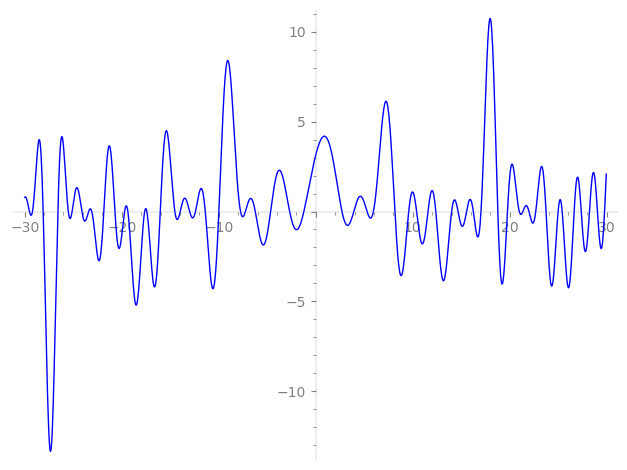| L(s) = 1 | + (3.98 + 0.292i)2-s − 14.7i·3-s + (15.8 + 2.33i)4-s + 5.38·5-s + (4.33 − 59.0i)6-s − 54.2i·7-s + (62.4 + 13.9i)8-s − 137.·9-s + (21.4 + 1.57i)10-s + 116. i·11-s + (34.5 − 234. i)12-s − 133.·13-s + (15.8 − 216. i)14-s − 79.6i·15-s + (245. + 73.9i)16-s + 296.·17-s + ⋯ |
| L(s) = 1 | + (0.997 + 0.0732i)2-s − 1.64i·3-s + (0.989 + 0.146i)4-s + 0.215·5-s + (0.120 − 1.63i)6-s − 1.10i·7-s + (0.975 + 0.218i)8-s − 1.70·9-s + (0.214 + 0.0157i)10-s + 0.966i·11-s + (0.240 − 1.62i)12-s − 0.791·13-s + (0.0810 − 1.10i)14-s − 0.354i·15-s + (0.957 + 0.288i)16-s + 1.02·17-s + ⋯ |
\[\begin{aligned}\Lambda(s)=\mathstrut & 92 ^{s/2} \, \Gamma_{\C}(s) \, L(s)\cr =\mathstrut & (-0.146 + 0.989i)\, \overline{\Lambda}(5-s) \end{aligned}\]
\[\begin{aligned}\Lambda(s)=\mathstrut & 92 ^{s/2} \, \Gamma_{\C}(s+2) \, L(s)\cr =\mathstrut & (-0.146 + 0.989i)\, \overline{\Lambda}(1-s) \end{aligned}\]
Particular Values
| \(L(\frac{5}{2})\) |
\(\approx\) |
\(2.05235 - 2.37751i\) |
| \(L(\frac12)\) |
\(\approx\) |
\(2.05235 - 2.37751i\) |
| \(L(3)\) |
|
not available |
| \(L(1)\) |
|
not available |
\(L(s) = \displaystyle \prod_{p} F_p(p^{-s})^{-1} \)
| $p$ | $F_p(T)$ |
|---|
| bad | 2 | \( 1 + (-3.98 - 0.292i)T \) |
| 23 | \( 1 - 110. iT \) |
| good | 3 | \( 1 + 14.7iT - 81T^{2} \) |
| 5 | \( 1 - 5.38T + 625T^{2} \) |
| 7 | \( 1 + 54.2iT - 2.40e3T^{2} \) |
| 11 | \( 1 - 116. iT - 1.46e4T^{2} \) |
| 13 | \( 1 + 133.T + 2.85e4T^{2} \) |
| 17 | \( 1 - 296.T + 8.35e4T^{2} \) |
| 19 | \( 1 + 395. iT - 1.30e5T^{2} \) |
| 29 | \( 1 - 1.23e3T + 7.07e5T^{2} \) |
| 31 | \( 1 - 647. iT - 9.23e5T^{2} \) |
| 37 | \( 1 - 804.T + 1.87e6T^{2} \) |
| 41 | \( 1 - 2.31e3T + 2.82e6T^{2} \) |
| 43 | \( 1 - 2.08e3iT - 3.41e6T^{2} \) |
| 47 | \( 1 - 2.72e3iT - 4.87e6T^{2} \) |
| 53 | \( 1 + 4.15e3T + 7.89e6T^{2} \) |
| 59 | \( 1 + 1.32e3iT - 1.21e7T^{2} \) |
| 61 | \( 1 - 3.37e3T + 1.38e7T^{2} \) |
| 67 | \( 1 - 3.93e3iT - 2.01e7T^{2} \) |
| 71 | \( 1 - 10.0iT - 2.54e7T^{2} \) |
| 73 | \( 1 + 4.27e3T + 2.83e7T^{2} \) |
| 79 | \( 1 + 9.48e3iT - 3.89e7T^{2} \) |
| 83 | \( 1 + 3.87e3iT - 4.74e7T^{2} \) |
| 89 | \( 1 + 1.04e4T + 6.27e7T^{2} \) |
| 97 | \( 1 + 4.23e3T + 8.85e7T^{2} \) |
| show more | |
| show less | |
\(L(s) = \displaystyle\prod_p \ \prod_{j=1}^{2} (1 - \alpha_{j,p}\, p^{-s})^{-1}\)
Imaginary part of the first few zeros on the critical line
−12.99664668760812572458549835377, −12.39823126602685963856836599926, −11.38446819298813849706563688486, −9.985560429109670746462882056814, −7.74983489584819146422110024029, −7.24712760097288256069595627877, −6.23160911427369057507759341863, −4.65215151935053365559196243928, −2.68597999400733234376065400105, −1.22246879729988343765928606921,
2.70565379235235961485644551432, 3.92414501028168085036549745789, 5.29192166060623890041930540652, 5.94609635553247881333022069054, 8.161809854439384530501245944851, 9.585671919769432697230168774124, 10.39949243200252174858160934448, 11.57221204075652016830357849142, 12.37925481472763706513272360495, 14.00932107073689237939437346746

